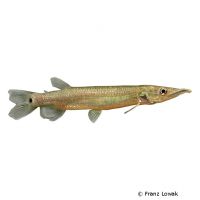Gar Characin (Ctenolucius hujeta)
| Gar Characin Ctenolucius hujeta | |
|---|---|
| Name | Gar Characin |
| Name Lat. | Ctenolucius hujeta |
| Synonym | Xiphostoma hujeta |
| Family | Pike Characids |
| Family lat. | Ctenoluciidae |
| Order | Characins |
| Order lat. | Characiformes |
| Origin | South America |
| Habitat | Rivers, pools |
| Diet | Carnivore |
| pH | 5.0-7.5 |
| Behavior | Predatory |
| Keeping | Individual, group |
| Care Level | Moderate |
| Reproduction | Egg scatterer |
| Breeding | Difficult |
| Life Span | 5-8 years |
| Protection | No |
| Metric Units | |
| Size | 20-25 cm |
| Temperature | 22-28 °C |
| Hardness | 5-20 °dH |
| Aquarium | 500 l |
| US Units | |
| Size | 7.9"-9.8" |
| Temperature | 72-82 °F |
| Hardness | 89-356 ppm |
| Aquarium | 150 gal |
Distribution and habitat
The predatory Hujeta Pike Tetras are common in northwestern Venezuela and northern Colombia, where they occur in the Maracaibo Basin and the Río Magdalena River system to the Rio Sinu. They live in rivers with clear, brownish colored water rich in humic substances near the surface usually under a cover of floating plants.
Maintenance
The aquarium should have a varied, dense planting that rises to the water surface, with shelters and hiding places (roots) and provide sufficient swimming space. A dark, sandy substrate covered with some foliage (e.g. sea almond leaves) as well as some floating plants, slightly acidic water and a weak current is ideal.
No ammonia, ammonium and nitrite should be detectable, the nitrate value should not exceed 100 mg/l. To ensure the water quality and oxygen content, a filter and heater adapted to the aquarium size is required, as well as lighting for the species-appropriate day-night rhythm of the animals.
Diet
In nature, these predators feed on small fish and insects. According to their size, the food supply consists of live food, such as worms, shrimps, insect larvae, etc., as well as forage fish, which is also accepted frozen. Occasionally, high protein, high quality dry food is accepted after habituation.
Only as much should be fed as is eaten immediately (in a maximum of 10 minutes). A regular and varied diet promotes health and increases resistance.
Behaviour and compatibility
It is recommended to keep them in a group of at least 4 animals. Within the species they usually behave peacefully. Young animals often form large groups, older ones often live solitary. Towards other fishes of the same size they often behave territorial, too small fishes are considered as prey.
Basically, only compatible fish species with similar demands on water quality and water temperature may be socialized.
Sex dimorphism
The sexes are very similarly colored, females are usually slightly larger and more plump than males.
Reproduction and breeding
There are isolated reports of successful breeding in the aquarium. Over 1,000 eggs are deposited on the water surface and after about 20 hours the larvae hatch. The fry must be fed several times a day with cyclops or Artemia nauplii. In a community tank breeding is hardly possible, because the spawn is easy prey here
Important
The tank should be well covered, as they are very skittish and good jumpers
Feeding live fish carries the risk of introducing parasites and other diseases. Meat from chickens or mammals (e.g. beef heart), should not be fed, as this food cannot be utilized by the fish.
The well-being of the fish should be checked regularly. Temperature should be checked daily, pH, hardness and nitrate levels should be checked at least every 14 days. Regular partial water changes are recommended, even if the contaminant level has not yet reached the upper limit. Sudden changes in water quality should be avoided. Newly introduced fish must be accustomed slowly to the water in the aquarium
Further literature can be found in your pet store.
References
Text: petdata; Image: Franz Lowak
Source: BMELV (1998): Tierschutzgutachten - Haltung von Zierfischen (Süßwasser); BAENSCH & RIEHL (2006): Aquarien Atlas Bd. 2, Mergus Verlag; ENGELMANN (2005): Zootierhaltung - Tiere in menschlicher Obhut: Fische, Verlag Harri Deutsch
- Gemäß § 21 Abs. 5 Tierschutzgesetz idgF
